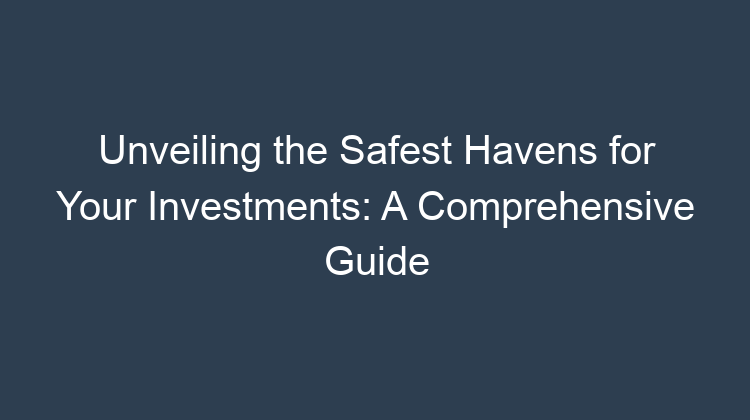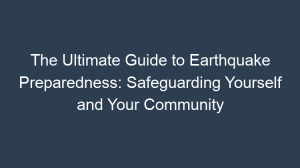Navigating the financial landscape can be daunting, especially when it comes to safeguarding your hard-earned money. In this comprehensive guide, we’ll delve into the world of secure investments, revealing the safest ways to invest your money while minimizing risks and maximizing returns.
Whether you’re a seasoned investor or just starting your financial journey, this guide will empower you with the knowledge and strategies necessary to make informed investment decisions. Dive in and discover the secrets to protecting your wealth and securing your financial future.
1. Understanding Investment Risk Tolerance: The Key to Safe Investing
The first step towards making safe investments is understanding your personal risk tolerance. Are you comfortable with the possibility of losing some money to achieve potentially higher returns? Or do you prefer a more conservative approach that prioritizes preserving your initial investment? Knowing your risk tolerance will help you choose investments that align with your comfort level.
1.1 Assess Your Current Financial Situation:
Evaluate your income, expenses, and savings to determine your financial stability and capacity to take risks.
1.2 Consider Long-Term Goals:
Think about your long-term financial objectives, such as retirement, education, or a down payment on a house. These goals will influence the level of risk you can afford to take.
1.3 Seek Professional Advice:
Consult with a financial advisor who can provide personalized guidance based on your unique circumstances and risk tolerance.
2. Minimizing Risk Through Diversification: Spreading Your Eggs in Multiple Baskets
Diversification is a fundamental principle of safe investing that involves spreading your money across different investments. By doing so, you reduce the impact of poor performance in any single investment on your overall portfolio. Diversification can be achieved through various strategies:
2.1 Asset Allocation:
Create a mix of asset classes, such as stocks, bonds, and real estate, to balance risk and potential returns.
2.2 Industry and Company Diversification:
Invest in companies from different industries and sectors to minimize the impact of industry-specific downturns.
2.3 Geographical Diversification:
Include investments in companies and markets from different countries to mitigate geographical risks.
3. Long-Term Investing: A Recipe for Safe Growth
Contrary to popular belief, short-term trading and market timing can be risky endeavors. The safest way to invest your money is by adopting a long-term strategy. When you buy and hold investments for an extended period, you ride out market fluctuations and increase your chances of profitability.
3.1 Compound Interest: The Magic of Time:
Long-term investing allows you to benefit from compound interest, where your interest earnings generate further interest.
3.2 Reduced Risk of Market Timing Errors:
By avoiding frequent buying and selling, you minimize the risk of making poor investment decisions based on short-term market movements.
3.3 Harnessing Market Cycles:
Over the long term, stock markets tend to trend upwards, allowing you to capture potential gains despite short-term volatility.
4. Dollar-Cost Averaging: Smoothing Out Your Investments
Dollar-cost averaging is a safe investment strategy that involves investing a fixed amount of money in a particular investment at regular intervals, regardless of the current market price. This approach helps reduce the impact of market volatility and minimizes the risk of buying high and selling low.
4.1 Reducing the Impact of Market Timing:
By investing at regular intervals, you avoid the need to time the market and potentially buying at a high price.
4.2 Lowering Investment Costs:
Dollar-cost averaging can help lower your average cost per share, as you may purchase some shares at a lower price and others at a higher price.
4.3 Building a Disciplined Investment Habit:
Regular investing instills discipline and helps you stay invested even during market downturns.
5. Using Bonds to Balance Your Portfolio
Bonds are generally considered less risky than stocks, as they provide a steady stream of income through regular interest payments. By incorporating bonds into your portfolio, you can reduce overall risk and diversify your investments.
5.1 Choosing the Right Bonds:
Selecting bonds with a high credit rating and a long maturity date can help minimize the risk of default and price fluctuations.
5.2 Laddered Bonds:
Investing in bonds with different maturity dates can provide a steady stream of income and help you manage interest rate risk.
5.3 Diversification with Bonds:
Bonds can serve as a hedge against market downturns and provide stability to your overall portfolio.
6. Real Estate: A Tangible Investment Option
Real estate can be a safe and lucrative investment option, especially if you have the capital and knowledge to navigate the market. Whether you choose to invest in residential or commercial properties, rental income and potential appreciation can generate substantial returns.
6.1 Research and Due Diligence:
Thoroughly research the location, property condition, and rental market before making an investment decision.
6.2 Diversification with Real Estate:
Investing in properties in different locations and types can help spread risk and maximize returns.
6.3 Professional Management:
Consider hiring a property manager to handle the day-to-day operations and maintenance of your investment property.
7. Saving for Retirement: The Importance of a Safety Net
Retirement planning is crucial for securing your financial future. Whether you contribute to a 401(k), IRA, or other retirement savings plan, setting aside money now will provide you with a secure financial cushion during your golden years.
7.1 Start Early:
The sooner you start saving for retirement, the more time your money has to grow through compound interest.
7.2 Choose the Right Retirement Plan:
Explore different retirement plans and select the one that best suits your financial situation and retirement goals.
7.3 Maximize Your Contributions:
Aim to contribute the maximum allowed amount to your retirement plan each year to reap the full benefits of tax deductions and potential employer matching.
8. The Safety of Cash and Money Market Accounts
For those seeking the utmost safety and liquidity, cash and money market accounts are ideal investment options. While they offer lower returns compared to stocks and bonds, they provide a secure haven for your money and allow for easy access.
8.1 Liquidity and Convenience:
Cash and money market accounts offer easy access to your funds, making them suitable for short-term savings or emergency funds.
8.2 FDIC or NCUA Insurance:
Deposits in FDIC-insured banks or NCUA-insured credit unions are protected up to certain limits, providing an additional layer of security.
8.3 Low Risk and Stability:
Cash and money market accounts are considered extremely low-risk investments, making them a good choice for those seeking capital preservation.
FAQ: Unraveling Common Questions about Safe Investments
1. What is the safest investment for beginners?
For beginners, low-risk investments such as savings accounts, money market accounts, and short-term certificates of deposit are often recommended as they offer a safe haven for your money while providing a modest return.
2. How can I reduce the risk of my investments?
Diversification is key to reducing investment risk. Spread your money across different asset classes, industries, companies, and geographical locations to minimize the impact of poor performance in any single investment or market sector.
3. What is the best way to save for retirement?
To save for retirement effectively, it is advisable to start early, choose the right retirement plan, and maximize your contributions. Consider seeking professional advice to create a personalized retirement savings strategy.
4. Is real estate a safe investment?
Real estate can be a lucrative investment, but it also involves risk. Thorough research, due diligence, and diversification are essential to minimize risk and maximize returns in real estate investing.
5. How can I protect my investments from inflation?
To protect your investments from inflation, consider investing in assets that tend to perform well during inflationary periods, such as stocks, commodities, and real estate. Additionally, diversifying your portfolio and regularly rebalancing your investments can help mitigate the impact of inflation on your portfolio’s overall value.
Conclusion: Embracing Safety and Security in Your Investments
In the realm of investing, safety and security are paramount. By understanding your risk tolerance, employing diversification strategies, adopting a long-term investment approach, and exploring various safe investment options, you can navigate the financial markets with confidence, knowing that your hard-earned money is well-protected and poised for growth. Remember, there is no one-size-fits-all safe investment strategy; the best approach depends on your unique







